Amidst the rich tapestry of Chinese cuisine, few dishes carry the cultural significance and mouth-watering allure of the humble Chinese dumpling. These delightful parcels of dough, brimming with savory fillings, have been a staple in Chinese households for centuries, cherished not only for their delectable taste but also for the stories they tell about family, heritage, and the art of culinary craftsmanship.
In this post below, we will share how to make Chinese dumplings from scratch along with our favorite dumpling recipe, a classic pork and chive dumplings.
What Are Chinese Dumplings?
Jiaozi (饺子), commonly called Chinese dumplings, represent a cherished traditional Chinese delicacy crafted from a basic blend of dough and diverse fillings. Not to be confused with soup dumplings (小笼包), which are typically round and contain a rich, delicious soup broth.
Chinese dumpling dough typically consists of wheat flour and water, yielding a soft and elastic texture that can be skillfully rolled and molded into various shapes. On the other hand, the fillings offer incredible diversity, presenting a vast array of flavors and ingredient combinations to tantalize the taste buds.
Pork dumplings are the most classic dumplings, and pork and chive dumplings are also a classic choice in Northern China. Common dumpling fillings include minced meat (pork, beef, chicken, or lamb), seafood (shrimp, fish), vegetables (Chinese cabbage, Chinese chives, mushrooms), and a variety of seasonings like ginger, garlic, soy sauce, and sesame oil.
Additionally, they can be boiled, steamed, pan-fried, or deep-fried, each method offering a unique taste and texture to the dumplings. Always accompanied by a flavorful dipping sauce, typically a combination of soy sauce, vinegar, sesame oil, and chili oil.
Traditional Chinese Pork And Chive Dumplings
Prep Time
30 minutes
Cook Time
10 minutes
Rest Time
30 minutes
Total Time
70 minutes
Ingredients
Filling
Dumpling Dough
Directions
Make the dough
1. Mix the all-purpose flour and a pinch of salt in a large mixing bowl.
2. Slowly pour warm water into the flour while stirring with chopsticks or a fork.
3. Keep adding water until the dough forms and comes together.
4. Knead the dough with your hands until it reaches a smooth and elastic consistency. If the dough appears too sticky, incorporate a small amount of additional flour; if it seems too dry, add more water as needed.
5. Place a damp cloth or plastic wrap over the dough, allowing it to rest for approximately 30 minutes.
Prepare the filling
1. In a large mixing bowl, combine the ground pork, chopped chives, minced garlic, grated ginger, soy sauce, oyster sauce, cooking wine, white pepper, and a pinch of salt.
2. Mix everything thoroughly until well combined. You can also use your hands to knead the mixture, which helps to develop a better texture.
Assemble the dumplings
1. After the dough has rested, split it into smaller portions for more convenient handling. The size of each portion will depend on the desired size of your dumplings and the number you want to make.
2. Sprinkle a light dusting of flour on your work surface, whether it's a clean countertop or a large cutting board, to prevent the dough from sticking while rolling it out.
3. Grab a single portion of the dough and use your hands to flatten it into a disk shape gently. Use a rolling pin to roll the dough out from the center to the edges, applying even pressure. While rolling out the dough, remember to rotate it periodically to ensure even thickness and prevent it from sticking to the surface.
4. Roll the dough to achieve your preferred thickness. Dumpling wrappers are typically thin, but the thickness can vary based on personal preference and the type of dumplings you're making. Strive for wrappers with a diameter of approximately 3-4 inches for regular-sized dumplings.
5. Place a small spoonful of the filling (about 1 to 1.5 teaspoons) in the center of the dumpling wrapper.
6. Dampen the edges of the dumpling wrapper with water to seal the dumpling.
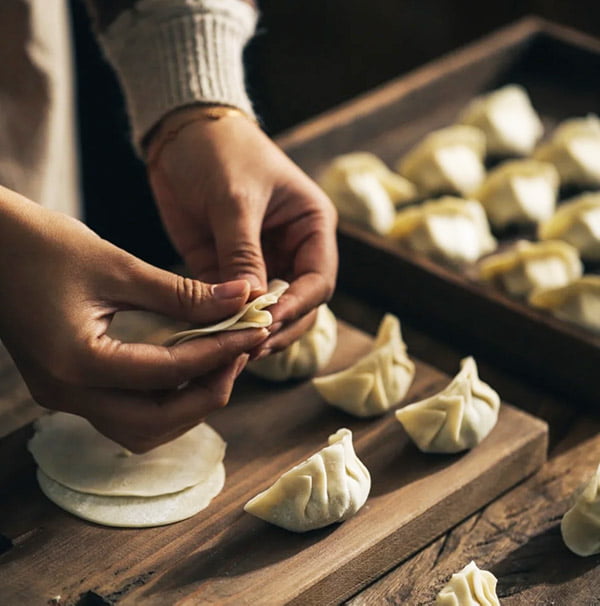
7. Fold the dumpling wrapper in half and firmly press the edges together to create a tight seal. You can use pleats to create a decorative pattern or simply press the edges firmly to seal into a half-moon shape.
8. Continue repeating this process until you have utilized all the filling or the dumpling dough.
Cook the dumplings
Boiling: Boiling dumplings is one of the most common and straightforward methods. This technique results in tender and juicy dumplings with a soft texture. Here's how to boil dumplings:
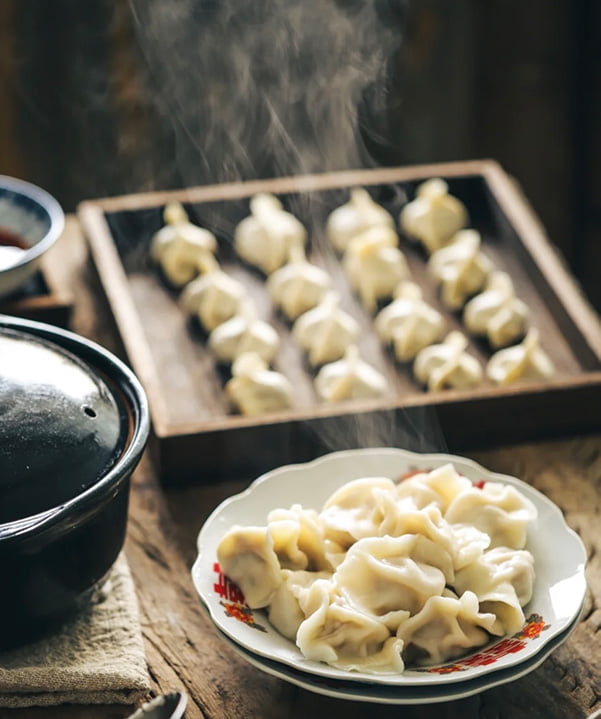
1. Boil Water: Fill a large pot with water and heat it until it reaches a rolling boil. You want enough water to fully submerge the Chinese dumplings during cooking.
2. Add Dumplings to the Boiling Water: With caution, lower the Chinese dumplings one by one into the boiling water. Stir gently to prevent the dumplings from sticking together or to the bottom of the pot.
3. Cook the Dumplings: Place the Chinese dumplings in boiling water for 5-6 minutes or until they rise to the surface. Floating indicates that the dumplings are fully cooked and the filling is cooked through.
4. Remove Boiled Dumplings from Water: After the Chinese dumplings have floated to the surface, use a slotted spoon or a strainer to remove them from the water carefully.
Steaming: Steaming dumplings is a popular and traditional cooking method that preserves the delicate flavors and textures of the filling. Steamed dumplings have a moist and tender texture, making them a delightful and healthier option than fried dumplings. Here's how to steam dumplings:
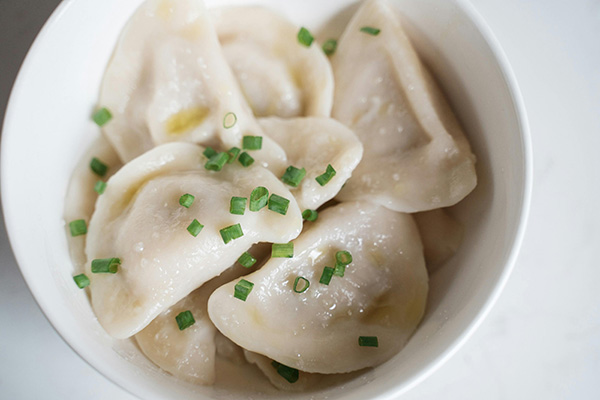
1. Line the Steamer Basket: To prevent the Chinese dumplings from sticking to the surface, line the steamer basket with parchment paper or cabbage leaves.
2. Bring water to a Simmer: Fill a pot or a wok with water about 1-2 inches deep. Gradually heat the water over medium heat until it reaches a gentle simmer.
3. Arrange the Dumplings: With care, position the dumplings in the steamer basket, ensuring there is some space between each one. Avoid overcrowding the dumplings, as they will expand slightly during cooking.
4. Steam the Dumplings: Place the steamer basket with the dumplings over the simmering water. Place a lid on the pot or wok to trap the steam, and steam the dumplings for approximately 8-10 minutes or until thoroughly cooked.
5. Check for Doneness: To determine if the dumplings are cooked, insert a toothpick or skewer into the center of one of them. The steamed dumplings are done if the toothpick comes out clean and the filling is no longer pink.
Pan-Frying: Pan-frying dumplings, also known as "potstickers" or "guotie" in Chinese cuisine, are a popular cooking method that creates a delicious combination of crispy bottoms and tender, juicy filling. Pan-frying enhances the flavor and adds a delightful texture to the dumplings. Here's how to pan-fry dumplings:
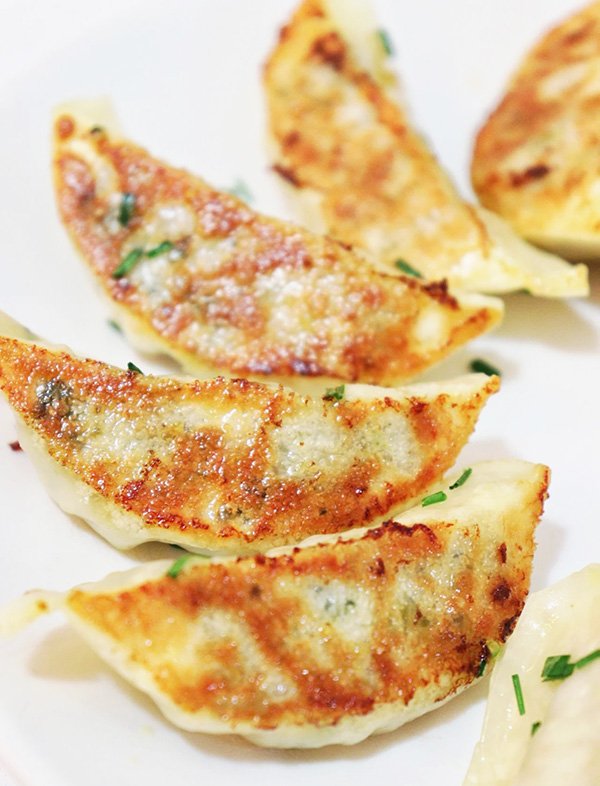
1. Heat the Pan: For optimal results, opt for a non-stick pan or a well-seasoned cast-iron skillet. Place the pan over medium heat and add a small amount of oil to coat the bottom of the pan.
2. Arrange the Dumplings: Gently position the Chinese dumplings in the pan, ensuring some space between each one. The flat side (the side on the work surface) should be facing down, and the rounded side facing up.
3. Fry the Dumplings: Let the Chinese dumplings cook undisturbed for approximately 5 minutes or until the bottoms turn golden brown and become crispy.
4. Add Water and Cover: After nicely browning bottoms, add around 1/4 cup of water to the pan. Be cautious; the water might sizzle when it contacts the hot oil. Swiftly cover the pan with a lid to trap the steam inside.
5. Steam the Dumplings: The water will create steam, which helps cook the Chinese dumplings while keeping them tender. Allow the dumplings to steam for an extra 3-4 minutes.
6. Remove the Lid and Fry Again: Once the steaming is complete, remove the lid and cook the dumplings until all the water evaporates completely. This step will give the dumplings a final crispiness on the bottom.
7. Serve: Once the water has evaporated, the pan-fried dumplings are ready to be served. Use a spatula to carefully lift the dumplings from the pan, ensuring they don't stick to the surface.
Prepare the dipping sauce (optional):
1. Mix soy sauce, rice vinegar, sesame oil, and chili oil (if desired) in a small bowl.
2. For added flavor, consider incorporating chopped green onions or a sprinkle of sesame seeds.
Tips & Notes
Finely chop the chives: Finely chop the Chinese chives to ensure they distribute evenly throughout the filling, and you don't end up with large chunks of chives in the dumplings.
Don't overfill the dumplings: It's essential not to overstuff them to prevent them from bursting open while cooking. Use a conservative amount of filling and seal the edges tightly.
Seal the dumplings properly: To ensure a tight seal, dampen the edges of the wrapper with water. Then, firmly crimp or pleat the edges to prevent the filling from leaking during cooking.
Nutritional Facts
Nutrition Facts
Servings: 4
Calories
335
% Daily Value*
Total Fat 3g
4%
Saturated Fat 0.9g
5%
Cholesterol 46mg
15%
Sodium 291mg
13%"
Total Carbohydrate 50.3g
18%
Dietary Fiber 2.5g
9%
Total Sugars 0.8g
Protein 24.1g
Vitamin D 0mcg
0%
Calcium 42mg
3%
Iron 4mg
24%
Potassium 432mg
9%
*The % Daily Value (DV) tells you how much a nutrient in a food serving contributes to a daily diet. 2,000 calorie a day is used for general nutrition advice.
What Ingredients You Will Need To Make These Chinese Dumplings
Ground Pork
Ground pork is the main protein in the dumpling filling, imparting a flavorful, juicy, tender texture to the homemade dumplings. However, if ground pork is unavailable, you can substitute ground chicken, turkey, or firm tofu for a vegetarian version.
Chinese Chives (Garlic Chives)
To make chive dumplings, you will need Chinese chives. They have a mild garlic flavor and contribute a fresh, herbal taste to the filling. If Chinese chives are unavailable, you can easily substitute them with regular chives or green onions (scallions).
Garlic
Minced garlic contributes a robust and aromatic flavor to the filling, elevating the overall taste. If fresh garlic is unavailable, you can use garlic powder as a substitute, although the flavor may not be as pronounced.
Ginger
Grated ginger provides a warm, spicy kick to the filling and complements the other flavors. While fresh ginger is preferred, ground ginger can be used as a substitute.
Soy Sauce
Soy sauce imparts a salty and savory seasoning that brings out the umami in the filling. It serves as a vital ingredient in numerous Asian dishes. If you have a soy allergy or prefer a milder flavor, you can use tamari (gluten-free soy sauce) or coconut aminos as an alternative.
Oyster Sauce
Oyster sauce derived from oysters is a luscious and savory condiment that imparts a depth of flavor and a subtle sweetness to the filling. If you're vegetarian or allergic to oysters, you can substitute oyster sauce with vegetarian oyster sauce, mushroom sauce, or hoisin sauce.
Cooking Wine (E.G., Shaoxing Wine)
Cooking wine adds a delightful aroma and helps tenderize the meat while imparting a subtle wine flavor. Shaoxing wine is a popular Chinese cooking wine, but if it's not available, there are many Shaoxing wine substitutes you can use. For example, you can use dry sherry or Japanese mirin.
White Pepper
White pepper, prevalent in Chinese cuisine, boasts a gentler flavor than black pepper and contributes a subtle spiciness to the filling. If white pepper is unavailable, you can use black pepper as a substitute, though the color and flavor will exhibit slight differences.
Salt
Salt plays a crucial role in seasoning the filling and enhancing the flavors of the other ingredients. Feel free to adjust the amount of salt based on your personal taste preferences.
Dumpling Wrappers
If possible, make your own dumpling wrappers from dumpling dough using flour, water, and a pinch of salt. Making wrappers from scratch requires some time and effort, but it is totally worth every effort.
Homemade dumpling wrappers allow you to tailor the dumpling dough according to your specific tastes and dietary choices. Moreover, homemade wrappers offer a fresh, clean flavor without any added flavors or preservatives.
If you have limited time, purchase store-bought dumpling wrappers instead. Dumpling wrappers are thin sheets of dough used to encase the filling. You can find premade wrappers in Asian grocery stores.
Dipping Sauce (Optional)
The customary dipping sauce typically comprises soy sauce, rice vinegar, sesame oil, and occasionally chili oil or other seasonings. It adds extra flavor and tanginess to the dumplings. Feel free to customize the dipping sauce to your liking.
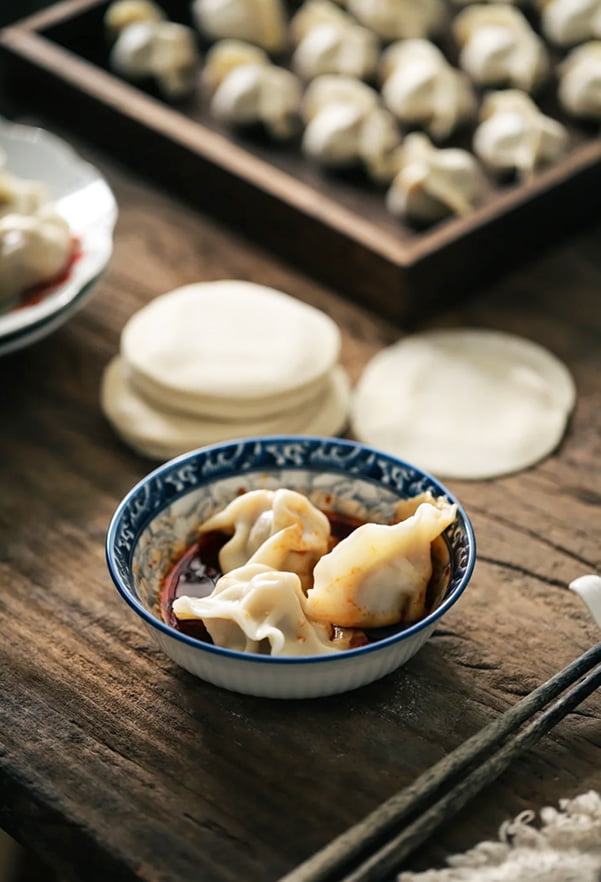
How To Store Leftover Dumplings
Cooked Dumplings
Storing leftover dumplings properly is essential to maintain their quality and safety for later consumption. Let the cooked dumplings cool down to room temperature before storing them. Leaving them out for too long can lead to bacterial growth, so try to refrigerate them as soon as possible after they are cooked.
Store the cooled leftover dumplings in an airtight container or a resealable plastic bag, removing as much air as possible to prevent moisture buildup, which can cause sogginess. Typically, leftover dumplings can be safely stored in the refrigerator for up to 3-4 days. Beyond that, the quality and safety of the dumplings may deteriorate.
Uncooked Dumplings
If you have uncooked dumplings that you want to store, make sure they are assembled and ready for cooking. Arrange the uncooked dumplings in a single layer on a baking sheet or a plate, making sure they are not touching to prevent sticking. Put the baking sheet with the dumplings in the freezer and allow them to freeze for about an hour or until they are partially frozen. This initial quick freeze helps prevent the dumplings from sticking together when stored in a container or bag. Once the dumplings are partially frozen, transfer them to an airtight container or a resealable plastic freezer bag. If using a bag, remove as much air as possible before sealing.
Uncooked dumplings can be stored in the freezer for several months, but for optimal quality, they should be used within 1-2 months. When you're ready to cook the frozen dumplings, there's no need to thaw them beforehand.
Dumpling Filling In Ideas
Chinese dumplings offer a wide range of filling options, and the combinations are practically limitless. Here are some popular Chinese dumpling-filling ideas:
Pork and Cabbage: This is another classic and traditional combo. The savory and juicy pork pairs perfectly with the cabbage's mild and slightly sweet flavor.
Chicken and Mushroom: Tender chicken combined with flavorful mushrooms creates a delicious and aromatic filling.
Beef and Carrot: Ground beef with finely grated carrots adds a touch of sweetness and vibrant color to the filling.
Shrimp and Chive: The delightful combination of succulent shrimp and chopped chives offers flavors and textures.
Vegetarian Delight: A mix of various vegetables like finely chopped cabbage, carrots, mushrooms, and tofu, seasoned with soy sauce and sesame oil, makes for a satisfying and flavorful vegetarian filling.
Pork and Shrimp: The richness of pork combined with the sweetness of shrimp makes for a delightful and savory filling.
Beef and Green Bean: Ground beef with finely chopped green beans adds a crunchy element to the filling.
Frequently Asked Questions (FAQ)
Can I Freeze Uncooked Dumplings?
Yes, you can freeze uncooked dumplings. Once you've assembled the dumplings, lay them in a single layer on a baking sheet and freeze them for approximately an hour. Then, transfer them to a container or bag for long-term freezer storage.
How Do I Cook Frozen Dumplings?
You can cook frozen dumplings directly without the need for thawing. Boil, steam, pan-fry, or deep-fry them using slightly adjusted cooking times to ensure they cook through properly.
How Do I Know When The Dumplings Are Fully Cooked?
The cooking time for dumplings may vary depending on their size and the chosen cooking method. Typically, dumplings are considered cooked when they float to the surface (boiling) or turn translucent (pan frying and steaming). Alternatively, you can cut one open to check if the filling is fully cooked.
How To Reheat Leftover Boiled Dumplings?
Pan frying is often considered one of the best ways to reheat boiled dumplings because it combines the best of both worlds – it helps retain the tender and moist texture from boiling while adding a crispy and flavorful crust to the dumplings.
What To Do With Leftover Filling?
Having leftover filling from making dumplings is not uncommon, and it presents an excellent opportunity to get creative and make other delicious dishes. You can make more dumplings, stuff them in vegetables and steam them, turn them into meatballs, add them to spring rolls, or freeze them and save them for later.
